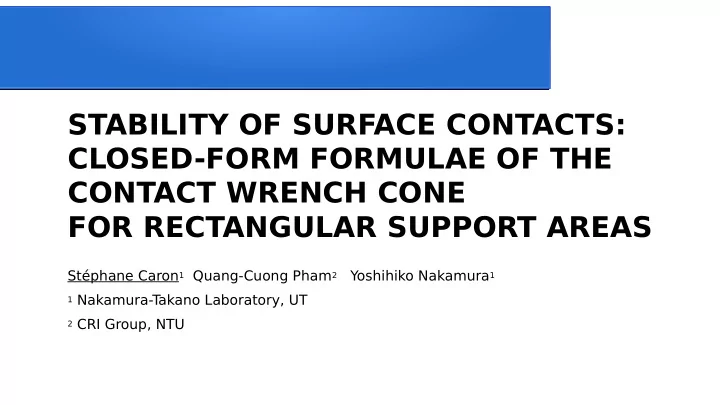

STABILITY OF SURFACE CONTACTS: CLOSED-FORM FORMULAE OF THE CONTACT WRENCH CONE FOR RECTANGULAR SUPPORT AREAS Stéphane Caron 1 Quang-Cuong Pham 2 Yoshihiko Nakamura 1 1 Nakamura-T akano Laboratory, UT 2 CRI Group, NTU
WH WHAT IS IS C CONTACT S T STABI BILI LITY? TY? Goal: locomote using environment forces Approach: Decide contact geometry – Maintain that contact (“stability”) – → position and force constraints Generate contact forces –
CONTACT C T CONDITI TION There are 6 DOF of contact: Three translations – Roll and pitch rotations – f Yaw rotation – Coulomb constraints: Normal translation: f z ≥ 0 – Surface translation: |f t | ≤ μ f z –
COP C CONDITI TION There are 6 DOF of contact: Three translations – Roll and pitch rotations – Yaw rotations – C COP constraints: Roll: -Y ≤ c y ≤ Y – Pitch: -X ≤ c x ≤ X –
COMPLETE TE C CONDITIO TION? There are 6 DOF of contact: Three translations – Roll and pitch rotations – Yaw rotation – ⇒ Contribution of the paper
SURF RFACE WRE WRENCH C CONE It constraints all 6 contact DOF We have its analytical formula Can be used with ≤ 6 DOF, e.g. sliding contacts Non-redundant representation, e.g. directly applicable to TOPP TOPP: Time-Optimal Path Parameterization
RECTANGU RE GULAR S R SURFACES Wrench Cone (16 rows) = – Coulomb condition (4 rows) – COP condition (4 rows) – Yaw condition (8 rows) (new)
ZMP A AREA IN IN SINGLE LE C CONTACT Single-contact: Surface Wrench Cone ⇔ ZMP/COP area Area is smaller than the foot contact surface Figure: μ = 0.1
APPL PPLIC ICATI TIONS
THANK YOU FOR YOUR ATTENTION :)
Recommend
More recommend